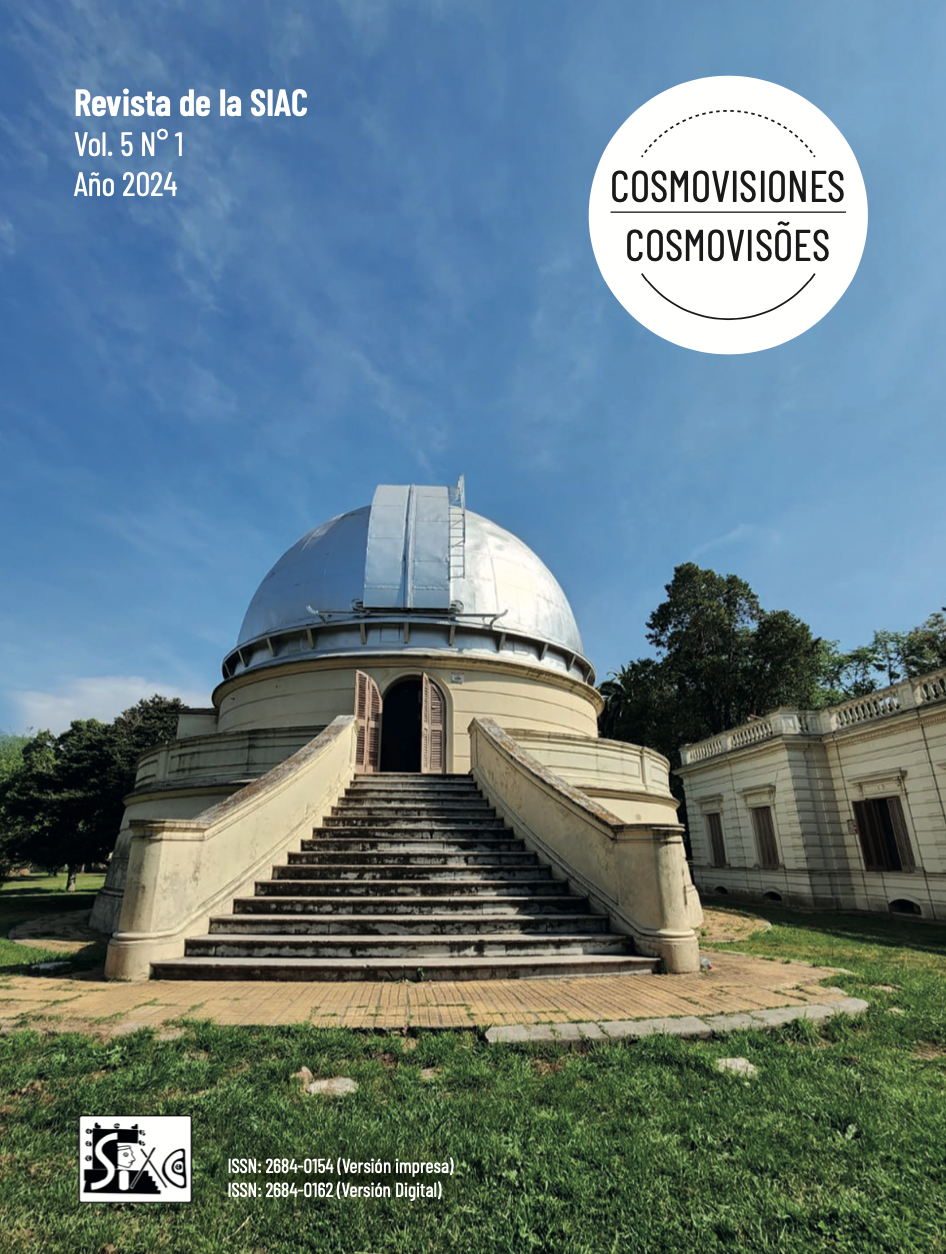Llamaqñawin (The eyes of the Celestial Llama,α and β Centauri), myths and the annual cycle of water in the Pachacámac Inca sanctuary
DOI:
https://doi.org/10.24215/26840162e021Keywords:
Pachacámac, Inca, water, archaeoastronomy, andean mythsAbstract
The Inca oracular sanctuary of the god Pachacama (organizer-energizer of time-space) began its heyday with Tupa Inca Yupanqui ca. 1465 AD, becoming the most important oracular-administrative centre of the coast, and second in importance in all the Tawantinsuyo, "the Inca empire of the four regions". Located on the rainless desert central coast of present-day Peru, the urban complex of adobe and stone buildings has four temples, fourteen structures with ramps, several courtyards and twenty-one edifices, occupying 1,250 acres. The urban layout presents three main alignments that establish its basic directions in almost all the structures in the central zone, the inner and most occupied area of the sanctuary.
Archeoastronomy studies in the sanctuary, with azimuth records taken in situ (1991-2009), as well as studies (2014-2018) using GIS software on aerial photographs, satellite images and panoramic contours, and 2019 drone survey of the sanctuary providing geo-photogrammetric data, confirm alignments directed mainly to the rising and setting of solstices, the major lunar standstills and the rising of α and β Centauri, revealing a landscape rich in cultural significance. The sanctuary’s astronomical layout, as a huge calendrical marker, would also allow an accurate annual record of the course of time and the important diagnosis and prognosis of hydro-climatic variations, both essential to organize propitiatory and preventive measures in ceremonial and agricultural activities.
Among the main building orientations of the sanctuary, the North Portal’s alignment with the Main Entrance street is remarkable. This long alignment pointed (circa 1500 AD) to the rising of α and β Centauri, known in Quechua as Llamaqñawin. This Main Entrance street with adjacent enclosures would have been a ceremonial transitive passage. These stars are also marked geographically at the place where the promontory of Pucusana hill (33 km away) touches the Pacific Ocean. Llamaqñawin are the “eyes” of the dark constellation known as Yacana, the “Celestial Llama”. In ethnohistorical documents of the central highlands of Peru the llama is related explicitly to the rainy season (Guamán Poma, 1615) and as custodian to the flow of water (Francisco de Avila, 1608). Thus, the alignment of the sanctuary’s main entrance directed towards the “Eyes of the Llama” is revealing, turning out to be a wake-up call about the element through which all life flows: water.
The sanctuary’s layout both records and celebrates the cycles of the celestial bodies, the rites, the myths, the weather cycles, and water cycles: sustenance of life. The sanctuary is indeed an Inca ceremonial administrative centre, but in the holistic, inclusive sense that the ancient Andean world attributed to the deity Pachacáma: the organizer and energizer of the whole, the foundation, the driving force of the synergies that sustains life in the totality of time-space.
Downloads
References
CURATOLA, M. (2017). Los oráculos de los confines del mundo: Pachacamac, Titicaca y el Inca Tupa Yupanqui. En Pachacamac: El oráculo en el horizonte marino del Sol poniente... (pp. 167 - 197). Fondo Editorial BCP.
GOSE, P. (1993) Segmentary State Formation and the Ritual Control of Water under the Incas. Comparative Studies in Society and History, 35 (3), 480-514. Cambridge University Press. http://www.jstor.org/stable/179143. Accessed 09/03/2023.
MAKOWSKI, K., & Ruggles, C. L. (2011). Watching the sky from the ushnu: the sukanka-like summit temple in Pueblo Viejo-Pucara (Lurin Valley, Peru). Proceedings of the International Astronomical Union, 7(5278), 169-177.
PINASCO, A. (2010) Punchaucancha, Templo Inca del Sol en Pachacamac. Lima: Pandero S.A. EAFC y Universidad Ricardo Palma.
PINASCO, A. (2022) Pachacámac: Templos, montañas, astros y agua. 2da. Edición. Lima: Universidad Ricardo Palma Editorial Universitaria.
POMA DE AYALA, G. (2006 [1615]). Nueva corónica y buen gobierno. www.kb.dk/permalink/2006/poma/info/es/frontpage.htm. Accessed 09/03/2023.
SANTILLÁN, H. (1968:28 [1563]). Relación del origen, descendencia, política y gobierno de los Incas. Ed. Atlas. Biblioteca de Autores Españoles, Vol. 209.
TAYLOR, G. (1999, 2011) Ritos y tradiciones de Huarochirí. [Francisco de Ávila 1608]. IFEA.
URTON, G. (1982) Astronomy and Calendrics on the coast of Peru. In Ethnoastronomy and Archeoastronomy in the American tropics. Aveni, A. and Urton, G. (Eds.). Annals of the N.Y. Academy of Sciences.
ZUIDEMA, T. and Gary Urton. (1976) La constelación de la llama en los Andes peruanos. Allpanchis Phuturinqa, Cusco, Vol. IX, 1976: 59–119.
Downloads
Published
How to Cite
Issue
Section
License
Copyright (c) 2024 Alfio Pinasco

This work is licensed under a Creative Commons Attribution-NonCommercial-ShareAlike 4.0 International License.
Authors who publish in this journal agree to the following terms:
The authors retain intellectual authorship of the work and guarantee the journal the right to be the first publication of the work.
Authors may share the work with acknowledgment of authorship and the initial publication in this journal.
Authors may separately establish additional agreements for the non-exclusive distribution of the version of the work published in the journal (for example, placing it in an institutional repository or publishing it in a book), with an acknowledgment of its initial publication in this journal.
The journal offers free access ("open access") to all its content. The articles are available to be read, downloaded, copied, printed and/or researched according to the Creative Commons license: CC BY-NC-SA (Attribution - Non-Commercial - Share Alike-4.0 International)

The content of the journal is fully available from its publication. Readers are required to correctly cite the journal and the author of the downloaded content
















